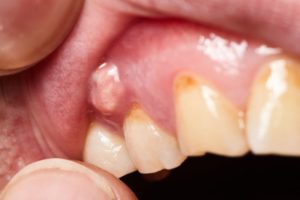
Most people associate root canals with the type of pain they cause—toothaches. That’s why you may be surprised to learn that you could need this procedure without experiencing any pain, depending on how far your tooth infection has progressed. It’s important to know what other signs to look out for that could signify that you need to see your emergency dentist for a root canal. Read on to learn five symptoms besides toothaches that could mean you need a root canal.
Cracked or Chipped Tooth
Teeth can become cracked or chipped for a variety of reasons, including something as simple as chewing on a piece of hard candy. Even though the damage may seem insignificant, it can expose the sensitive layers underneath the enamel (the dentin) and without treatment, could become infected with time.
Sensitivity to Temperature
The sensitive layer underneath the enamel, called the dentin, is comprised of microscopic tubules that channel from the inside of the tooth (known as the inner chamber, where a bundle of nerves is located), to the dentin itself. Once the enamel has worn away, an early sign of decay is sensitivity to hot and cold foods and beverages.
Swollen Gum Area
Swollen and tender gums are signs of a problem forming beneath the surface of the mouth. In some cases, an infection can even be indicated by bumps on the gums. In these cases, it’s likely that a root canal will help address the issue and keep it from getting worse.
Discoloration of Affected Tooth
While typical staining, like a yellow-ish tint forming over teeth, is common for people to experience, a tooth turning dark in color isn’t common and should be addressed immediately. Once bacteria are able to invade the interior of a tooth and kill off the pulp (nerve cluster) inside, it can kill the tooth and make it appear black. Depending on whether the tooth is alive or not will indicate whether a tooth extraction or root canal can be used to treat it.
Deep Decay
While a simple cavity may be able to be treated with a fast and effective filling, deeper, more extensive decay would likely require a root canal and crown. Once decay has set into the base of your tooth and extended its reach into the inner chamber, the only way to treat it and ensure it doesn’t spread is to remove the bacteria completely from within.
Although visiting an emergency dentist for a root canal can seem like a big deal, the more serious situation would not be addressing the issue as soon as you started to spot the signs of it. Now that you know other signs of infection besides toothaches, you can keep a sharp eye out to ensure your oral health remains on the right track.
About the Author
Dr. Giannina McBride has been in the dental field for several decades, first as a dental assistant, and beginning in 2002, as a private practice dentist and educator at universities. She’s passionate about staying up to date with the latest advancements in her field and regularly pursues continuing education. She’s also proud to offer flexible and high-quality emergency dental services, including same-day, walk-in, and weekend urgent appointments. If you’re in pain and need an emergency appointment, visit All Smiles Leesburg’s website or call 703-782-5171.
